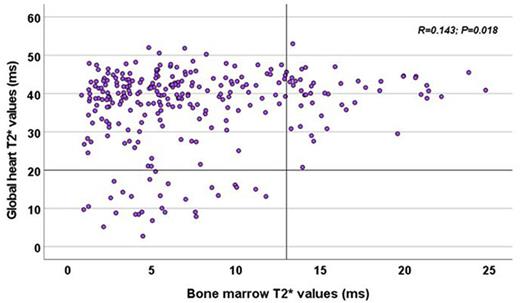Abstract
Introduction. T2* magnetic resonance imaging (MRI) is a well-established technique for the non-invasive quantification of organ-specific iron overload. However, to the best of our knowledge, no systematic T2* MRI studies focused on the bone marrow of thalassemia major (TM) patients are available in literature.
Aims. This study aimed to investigate the link between bone marrow and cardiac iron overload in TM.
Methods. We considered 274 TM patients (38.96±8.49 years, 151 females) consecutively enrolled in the Extension-Myocardial Iron Overload in Thalassemia (E-MIOT) network. Iron overload was quantified by the gradient-echo T2* technique. Bone marrow T2* values were obtained on a circular region of interest located in the visible body of the first or second lumbar vertebra. The left ventricle was segmented into a 16-segment standardized model and the T2* value on each segment was calculated as well as the global value.
Results. Bone marrow T2* values showed a weak positive correlation with global heart T2* values (R=0.143; P=0.018) (Figure 1) and a weak inverse correlation with the number of segments with T2*<20 ms (R=-0.119; P=0.050). Out of the 227 patients with a pathological bone marrow T2* value (<13 ms), 28 (12.3%) had a pathological global heart T2* value (<20 ms). No patients without iron overload in the bone marrow had significant myocardial iron overload.
In male patients, a bone marrow T2*<8.6 ms predicted the presence of significant MIO with a sensitivity of 92.3% and a specificity of 49.1% (P=0.001). The AUC was 0.71 (95% CI: 0.62-0.79). In female patients, the ROC curve did not reveal a bone marrow T2* threshold below which the probability of detecting significant MIO increases significantly with satisfying sensitivity and specificity (AUC=0.52; P=0.734).
Conclusion. This is the first study to demonstrate a link between iron deposition in the bone marrow and in the heart. The correlation coefficient was really weak, but a normal bone marrow T2* value showed a negative predictive value of 100% for cardiac iron. Moreover, in the male population we were able to identify a bone marrow T2* value which may help to identify the patients at high risk for myocardial iron overload. The presence of a high number of patients with a pathologic bone marrow T2* but a normal global heart T2* probably reflects a delay in cardiac iron uptake, different mechanisms of iron loading and unloading, and a different accessibility of iron chelators to different pools. Since bone marrow T2* measurements can be easily obtained using the same MRI sequences acquired for liver iron quantification and may bring new insights into the pathophysiology of iron deposition, they should be incorporated in clinical practice.
Disclosures
Maggio:Novartis: Membership on an entity's Board of Directors or advisory committees; Celgene Corp (Bristol Meyers Squibb): Membership on an entity's Board of Directors or advisory committees; Vertex: Membership on an entity's Board of Directors or advisory committees; Bluebird Bio: Membership on an entity's Board of Directors or advisory committees. Cademartiri:Chiesi Farmaceutici S.p.A: Other: no profit support; Bayer: Other: no profit support.
Author notes
Asterisk with author names denotes non-ASH members.


This feature is available to Subscribers Only
Sign In or Create an Account Close Modal